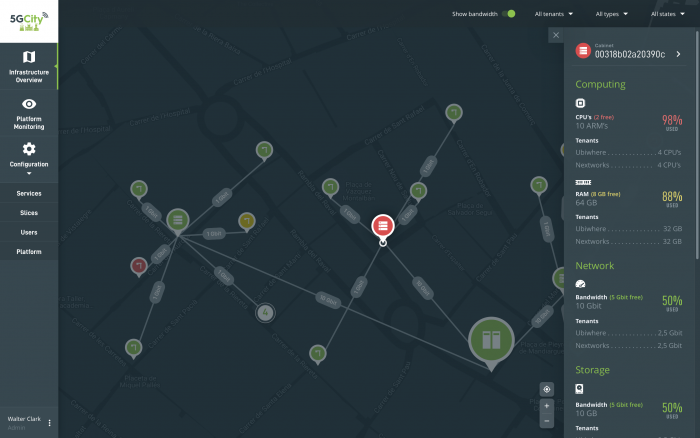
5GCity Neutral Host Dashboard

Author:
Ricardo Preto
Co-Author:
Pedro Diogo
The main goal of 5GCity is to define how to turn a city into a distributed and multi-tenant edge infrastructure enabling the orchestration and service programming of 5G services following a neutral host rational. These 5G services are expected to be used by municipalities to host Smart City services, by Virtual Network Operators (VNO) to extend their networks, and by additional third party providers such as media or automotive verticals to offer innovative services to their customers. 5GCity platform will allow managing the underlying physical infrastructure (spread across a geographical area) to offer a set of virtual resources to interested stakeholders (VNOs, Content/Service providers, …), who will build, on top, its own services ready for end-user consumption.
To achieve such a goal, 5GCity has designed and is currently implementing an Orchestrator responsible for the lifecycle management and orchestration of all 5G-based edge services and for the control and management of the available city edge infrastructure. It also includes 5G edge service-programming models, as well as a northbound API to enable access to the different edge services and the orchestrator functionalities (more information regarding 5GCity’s Orchestrator can be fetched here: https://www.5gcity.eu/2018/07/31/5gcity-nfv-orchestrator-platform/). Features developed by this Orchestrator, will be provided through an appealing and intuitive web interface abstracting most of the complexity associated with the steps required to manage end to end slices in a multi-tenant environment. Following a neutral host vision, different profiles are envisioned to be supported by this Dashboard filtering the features available in the web interface accordingly. The result will be the development of a solution that based on a leasing model will allow targeted stakeholders (aggregated under Slice Requester Role) to request end-to-end slices containing virtualized edge network and compute resources. A more concrete vision on the main roles supported by 5GCity Dashboard under the neutral host rationale focusing on its most critical features is provided below:
Infrastructure Owner
Users under this profile are considered as the owners of the underlay physical infrastructure that can be used for hosting the computing, storage and networking virtual resources. The available resources include space in street cabinets, lampposts or buildings along with power supply and connectivity facilities necessary to power and interconnect the ICT equipment. One of the most important features to be provided to these users, is the ability to check at any given instant, the leased status of its infrastructure. This view should allow these users to understand if further physical resources are required (always in a georeferenced way), enabling for instance that infrastructure upgrades are performed in places where the demand is higher. The following figure showcases 5GCity’s current vision on how this feature will be provided to Infrastructure Owner users.
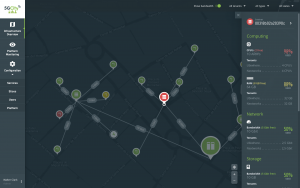
By visiting this page, Infrastructure Owners are able to quickly grasp the usage of physical resources currently available in the infrastructure. By selecting a resource, this users can check which entities (Slice Requesters) have leased its resources as well as the amount of resources still free to be leased. A set of filters is also provided, allowing for instance to visualise the resources leased by a specific entity (Slice Requester).
Furthermore, a summary view on the amount of resources available versus the amount of resources already reserved is also required. To achieve this, 5GCity envisions to enable the following view:
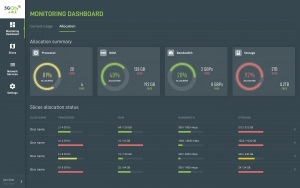
Using this view, Infrastructure Owners will be able to quickly grasp if the platform is able to accommodate new slice requests from already registered or potentially new Slice Requester entities.
Slice Requester
This profile will include all entities interested in using 5GCity’s available virtual resources to create and provide their own end to end services. By taking advantage of the 5GCity architecture and the Neutral Host concept, these users will be able to request, and upon acceptance use, slices containing both computational and network virtual resources. As a consequence, one of the most important features to be provided to these users is the ability to define the requested resources in a georeference way and in the context of a slice (to be accepted/rejected by a Infrastructure Owner). To achieve so, users must be able to see the available resources and lease them in the context of a slice. In the figure below, is available the interface envisioned by 5GCity that will enable this feature.
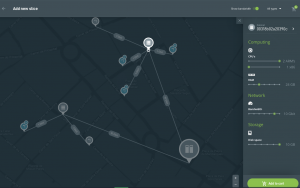
After Infrastructure Owner approves a slice, Slice Requester will be able to instantiate Network Services using the resources of a slice which they own. Multiple network services will be able to be instantiated in each slice, so a view on the resource usage of a slice (such as the one displayed below) is also critical for this user profile.
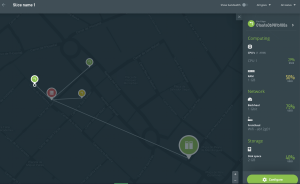
In summary 5GCity’s dashboard interface aims to be appealing and intuitive allowing multiple user profiles to perform their envisioned tasks as quickly as possible. How information is visualized is a critical point to consider in order to provide an interface that does not overwhelm users with information, features and complexity. 5GCity will provide a dashboard that abstracts most of the complexity associated with the orchestration of a multi-tenant and sliceable infrastructure, encouraging the usage of its usage while also allowing efficient and fast deployments of innovative end to end services. Implementation work is in progress based on this vision, however, the previous screens already showcase the direction aimed by the project.
